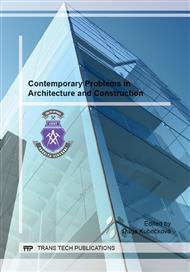p.297
p.303
p.308
p.314
p.317
p.323
p.329
p.335
p.341
Shrinkage of Industrial Concrete Floors
Abstract:
The paper deals with issues connected to shrinkage of industrial concrete floors and the consequent formation of cracks within the structure, since it handles about an undesirable effect. A huge number of cracks may cause serious defects and faults. The beginnings of the paper do summarise the theoretical background of volumetric changes, discusses their types and explains the possible methodologies for their measurements, the major objective of which is focused on the determination of the amount of cracks. Inside of the experimental part three samples are monitored with respect to shrinkage. The measurements are done with the utilisation of a shrinkage drain and are carried out for a time interval of 12 hours, whereas the structure moves the most under this particular time period. In the last chapters it comes to an evaluation of the results. This includes a comparison of obtained data against normative requirements dealing with shrinkage, and a subsequent a comparison of samples, since the observations are done under the exact same boundary conditions
Info:
Periodical:
Pages:
317-322
Citation:
Online since:
October 2014
Authors:
Price:
Сopyright:
© 2014 Trans Tech Publications Ltd. All Rights Reserved
Share:
Citation:


